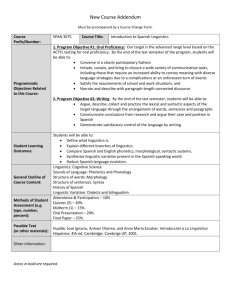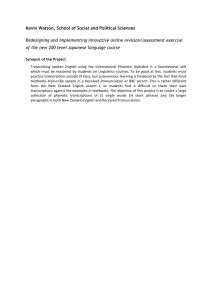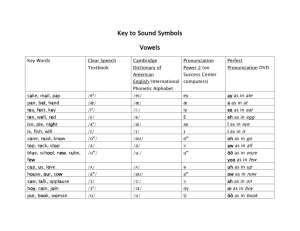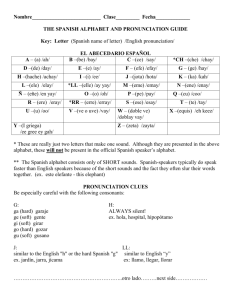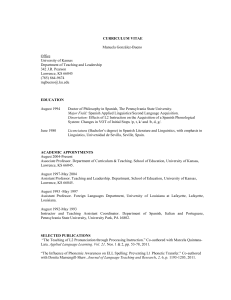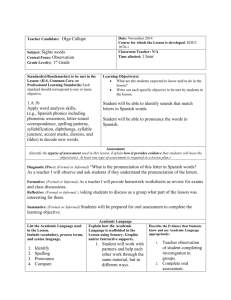Modified Approximants in L2 Spanish Teacher Talk
advertisement
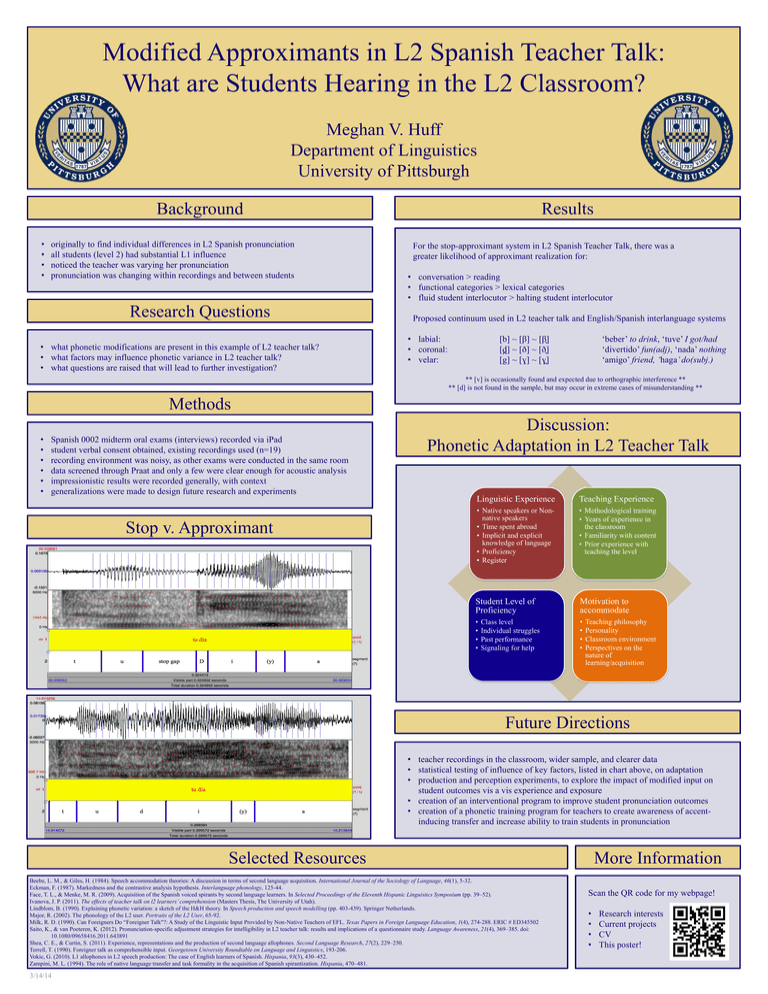
Modified Approximants in L2 Spanish Teacher Talk: What are Students Hearing in the L2 Classroom? Meghan V. Huff Department of Linguistics University of Pittsburgh Background • • • • originally to find individual differences in L2 Spanish pronunciation all students (level 2) had substantial L1 influence noticed the teacher was varying her pronunciation pronunciation was changing within recordings and between students Research Questions • what phonetic modifications are present in this example of L2 teacher talk? • what factors may influence phonetic variance in L2 teacher talk? • what questions are raised that will lead to further investigation? Results For the stop-approximant system in L2 Spanish Teacher Talk, there was a greater likelihood of approximant realization for: • conversation > reading • functional categories > lexical categories • fluid student interlocutor > halting student interlocutor Proposed continuum used in L2 teacher talk and English/Spanish interlanguage systems • labial: • coronal: • velar: ‘beber’ to drink, ‘tuve’ I got/had ‘divertido’ fun(adj), ‘nada’ nothing ‘amigo’ friend, ‘haga’ do(subj.) [b] ~ [β] ~ [β̞] [d̪] ~ [ð] ~ [ð̞] [g] ~ [ɣ] ~ [ɣ̞] ** [v] is occasionally found and expected due to orthographic interference ** ** [d] is not found in the sample, but may occur in extreme cases of misunderstanding ** Methods • • • • • • Spanish 0002 midterm oral exams (interviews) recorded via iPad student verbal consent obtained, existing recordings used (n=19) recording environment was noisy, as other exams were conducted in the same room data screened through Praat and only a few were clear enough for acoustic analysis impressionistic results were recorded generally, with context generalizations were made to design future research and experiments Stop v. Approximant Discussion: Phonetic Adaptation in L2 Teacher Talk Linguistic Experience Teaching Experience • Native speakers or Nonnative speakers • Time spent abroad • Implicit and explicit knowledge of language • Proficiency • Register • Methodological training • Years of experience in the classroom • Familiarity with content • Prior experience with teaching the level Student Level of Proficiency Motivation to accommodate • • • • • • • • Class level Individual struggles Past performance Signaling for help Teaching philosophy Personality Classroom environment Perspectives on the nature of learning/acquisition Future Directions • teacher recordings in the classroom, wider sample, and clearer data • statistical testing of influence of key factors, listed in chart above, on adaptation • production and perception experiments, to explore the impact of modified input on student outcomes vis a vis experience and exposure • creation of an interventional program to improve student pronunciation outcomes • creation of a phonetic training program for teachers to create awareness of accentinducing transfer and increase ability to train students in pronunciation Selected Resources Beebe, L. M., & Giles, H. (1984). Speech accommodation theories: A discussion in terms of second language acquisition. International Journal of the Sociology of Language, 46(1), 5-32. Eckman, F. (1987). Markedness and the contrastive analysis hypothesis. Interlanguage phonology, 125-44. Face, T. L., & Menke, M. R. (2009). Acquisition of the Spanish voiced spirants by second language learners. In Selected Proceedings of the Eleventh Hispanic Linguistics Symposium (pp. 39–52). Ivanova, J. P. (2011). The effects of teacher talk on l2 learners’ comprehension (Masters Thesis, The University of Utah). Lindblom, B. (1990). Explaining phonetic variation: a sketch of the H&H theory. In Speech production and speech modelling (pp. 403-439). Springer Netherlands. Major, R. (2002). The phonology of the L2 user. Portraits of the L2 User, 65-92. Milk, R. D. (1990). Can Foreigners Do “Foreigner Talk"?: A Study of the Linguistic Input Provided by Non-Native Teachers of EFL. Texas Papers in Foreign Language Education, 1(4), 274-288. ERIC # ED345502 Saito, K., & van Poeteren, K. (2012). Pronunciation-specific adjustment strategies for intelligibility in L2 teacher talk: results and implications of a questionnaire study. Language Awareness, 21(4), 369–385. doi: 10.1080/09658416.2011.643891 Shea, C. E., & Curtin, S. (2011). Experience, representations and the production of second language allophones. Second Language Research, 27(2), 229–250. Terrell, T. (1990). Foreigner talk as comprehensible input. Georgetown University Roundtable on Language and Linguistics, 193-206. Vokic, G. (2010). L1 allophones in L2 speech production: The case of English learners of Spanish. Hispania, 93(3), 430–452. Zampini, M. L. (1994). The role of native language transfer and task formality in the acquisition of Spanish spirantization. Hispania, 470–481. 3/14/14 More Information Scan the QR code for my webpage! • • • • Research interests Current projects CV This poster!


